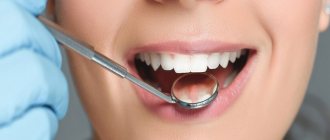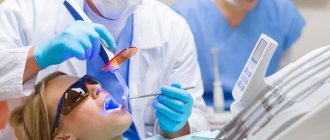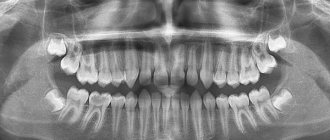Rotten, caries-affected and weakened teeth are not only an aesthetic problem.
Often they become the cause or consequence of serious diseases of internal organs and systems, leading to a decrease in their function and pathological changes. The psychological state of the patient also changes, discomfort appears when smiling, and bad breath appears.
There is a whole scheme that determines the relationship between diseased teeth and vital organs. Untreated caries almost always leads to serious heart and joint diseases, liver or intestinal dysfunction.
The problem occurs not only in adults; caries can affect barely erupted teeth in infants.
In adults
More often this disease is diagnosed in the adult part of the population. This is due to the fact that over time, a large number of factors appear that affect the entire body as a whole and the condition of the oral cavity in particular.
One of the most common diseases in dentistry is caries. At its core, it means rotting. Caries begins to appear from the upper – coronal part.
However, in some cases, the process may begin not from the crown, but from the lower part - the roots. Then they notice it much later, and it is much more difficult to cope with the consequences later.
We will tell you about Crest toothpaste and its most popular types.
This article describes how cervical caries can be cured.
Here: https://www.vash-dentist.ru/krasota-i-uxod/zubnyie-shhetki/curaprox-opisanie-preimushhestva-za-kakuyu-tsenu-mozhno-kupit.html - they will tell you whether it’s worth buying a toothbrush Curaprox.
Stages of destruction and symptoms
There are several stages of this disease. Each of them manifests itself in a different way.
- Bad breath , which appears at first only sometimes, and then is felt constantly, even when talking. Most often, its source is plaque containing a large number of pathogenic bacteria.
- With further development, spots may appear on the visible part - the enamel .
- Then black areas appear . Sometimes such damage, manifested as blackness, can be found on the root. However, in this case they are not visible during a normal superficial examination. In order to find out where the process began, it is necessary to take an x-ray.
- At the next stage, when the blackness is replaced by the formation of a small cavity in the crown or other part of the tooth , the body begins to actively signal the problem with the appearance of unpleasant and later painful sensations.
- After this, if the patient still has not consulted a doctor, the pain intensifies and can become unbearable, sharp and very long-lasting . This means that the rotting process has reached the inner part - the pulp. Now the soft tissues of the tooth, containing the nerve bundle, blood and lymphatic vessels, are affected.
- If the disease began from the coronal part, then after the nerve is destroyed, the pain may disappear, and decay will spread to the roots . If on the contrary, by this time the tooth may simply fall out , but if not, you will simply have to remove it along with the root.
Among other things, rotten teeth create a very unpleasant external impression. This is why people suffering from this disease stop actively communicating and become withdrawn and unsociable.
All this makes life quite difficult, and, in addition, is fraught with negative consequences for the entire body and influences the functioning of individual systems and organs.
Stages of destruction
Tooth decay does not happen overnight. The decay process can take several months, and sometimes six months. It is rare that the cause of the disease is autoimmune diseases or any pathologies.
More often than not, bad teeth are the result of the patient’s dishonest attitude towards his own oral cavity. At any stage of caries development, treatment can be started and the decay process can be prevented from spreading to other teeth. Caries is usually classified according to the following stages:
The appearance of a chalk spot
It is difficult to visually determine the onset of caries; the stain does not cause pain. If you start treatment at this stage, then during preparation you can see how seriously the tooth is damaged from the inside. Sometimes the stain can be cured with a simple fluoride application.
The occurrence of caries
Caries is classified into superficial, medium, deep. The first signs of tooth decay include a reaction to cold and acidic foods. Deep damage by caries manifests itself in the form of constant aching pain, which is often widespread and disappears only after pressing or rinsing with special means.
Pulpitis
Occurs as a result of pulp damage. It is a dental cavity filled with nerve endings, blood vessels and capillaries. Pain due to pulpitis appears at night, when drinking hot or cold drinks. Tooth treatment for pulpitis involves removing the nerves from the canals and thoroughly filling them.
Periodontitis
At the last stage, the pain becomes constant, the tooth begins to loosen, and the inflammatory process spreads to the ligaments. Possible increase in body temperature, extensive sepsis, and the addition of symptoms of general intoxication.
When preparing a dental cavity in the final stages of carious lesions, less than half of the natural tooth remains. The sooner treatment for caries begins, the longer your teeth will remain healthy.
Learn more about dental numbering schemes. In this section you will find photos of gingival fibromatosis.
At this address you will find complete information about effective antibiotics in the treatment of toothache.
Why do they appear?
There are quite a few reasons that serve as the beginning of the process of tooth decay. All of them can be divided into several groups or categories depending on whether they are internal or external factors.
The first is the reasons that appear due to the fault of the person himself.
- Smoking . It occupies the top position due to its great importance. The fact is that smoking significantly worsens metabolic processes in the tissues of the oral cavity, in particular teeth. Therefore, they cannot resist adverse effects in the form of plaque, bacteria, and so on. In addition, the substances contained in cigarette smoke themselves contribute to the destruction of enamel.
- Other bad habits, including alcohol and drug use . This greatly weakens the entire body and impairs its ability to recover and protect itself.
- Quite a poor nutritional culture and frequent consumption of unhealthy foods . Their list includes not only those that have a bad effect on the body, but also those that have a direct effect on the enamel - all kinds of sweets, a large number of berries and fruits with high acidity.
- You can also add an incorrect, unhealthy lifestyle . Its consequences have an indirect effect on the condition of the teeth through a decrease in the defenses of the entire body.
- Lack of hygiene also plays a huge role.
The second group is external circumstances that do not depend on the patient
- Poor environmental situation in most human-inhabited areas. This includes polluted air, bad water, which contains a large number of harmful additives and impurities, as well as a common deficiency of fluoride in it.
- Heredity plays a very important role . After all, all problems with enamel or tooth development generally increase the risk of decay.
- The presence of certain (temporary and infrequent) physiological conditions . This includes the period of intensive growth in adolescents, pregnancy and breastfeeding. At this time, the hormonal balance changes and all the body’s forces are directed towards completely different goals.
We have collected reviews of Sensodyne toothpaste, which has become especially popular among customers today.
Our article talks about the causes of black plaque on the tongue and how to treat it.
Here: https://www.vash-dentist.ru/krasota-i-uxod/narashhivanie/skolko-budet-stoit-zub.html - you will find out how much it costs to grow a tooth.
The third group is the presence of general and dental diseases
- Diseases of periodontal tissues . This can be either gingivitis or periodontitis and periodontal disease, which are more difficult to treat and have a more severe effect on the teeth.
- Diseases of the gastrointestinal tract, liver, thyroid gland, infectious diseases related to dentistry, and others.
- The presence of a cyst in the gum near the roots . This is a formation with dense walls that can be filled with pus. If the infection continues, the teeth will also rot.
Treatment tactics
When determining treatment tactics, the dentist is guided by the general condition of the problem tooth, the stage of carious lesions, and the patient’s general clinical history. There are two treatment options: medication and dental.
Medicines
The medical route involves treating a tooth without opening its cavity. Often this route is acceptable when the caries is in the chalky stage (white, pigmented).
The action of the drugs is aimed at suppressing the activity of pathogenic microflora and restoring damaged tooth enamel. There are two groups of drugs for the treatment of caries:
- Fluorine-containing (sodium fluoride, fluoride ions, fluoride varnish, salt containing fluoride, fluoridated water). Treatment occurs with the help of rinsing and applications and ensures the strengthening of damaged enamel.
- Calcium-containing (gluconate, lactate, glycerophosphate, phytin). The products ensure the density of the tooth structure and restore visible damage.
Drug treatment helps in 85% of all clinical cases. When conservative treatment in the early stages of caries formation is not effective, then preparation of the dental cavity is used.
In dentistry
In most cases, treatment of caries at any stage of development is carried out using a drill, which removes the dark carious layer. In milder cases, it is enough to remove plaque and fill the tooth.
In case of advanced caries, the nerves are removed, the canals are filled and the main filling is applied. The indication for tooth preparation is caries at any stage of development, as well as contraindications to drug treatment in the early stages of pathogenic formation.
Alternative medicine
Home treatment methods are used when it is impossible to immediately visit the dental office at the very beginning of a carious lesion . In the later stages of caries development, treatment with herbal rinses alone will be ineffective.
Traditional medicine recipes are intended for quick pain relief, preventive measures against caries, and as a comprehensive treatment of the oral cavity with medications. The most effective include:
- sage tincture (a natural antiseptic that affects the development of pathogenic microflora and putrefactive bacteria);
- propolis tincture (an antiseptic for local cauterization and rinsing, eliminates pain, relieves initial carious damage);
- laundry soap (cleaning with a soap solution is an excellent prevention of caries);
- decoction of onion peels (disinfects the oral cavity);
- calamus tincture (the product fills all microcracks and relieves pain in the rhizome of the tooth);
- fir oil (relieves aching pain, disinfects putrefactive formations in the tooth cavity).
It is not always wise to rely on the power of folk methods. It is important to know that there is nothing better than a dental examination and quality treatment within the walls of professional offices.
You will learn more about the treatment of caries with folk remedies from the video.
In children
This unpleasant and even dangerous phenomenon occurs not only in adults. Quite often, tooth decay begins in young children. Moreover, this can happen even before the entire row of baby teeth is formed.
Often parents are very frightened by the speed of this process. Indeed, literally within a few months after eruption, decay can reach an already obvious and complex stage.
For children there are no special separate causes of this disease. They are the same as for adults. However, some of them are more important.
- Firstly, this is the huge consumption of caramel and other sweets , to which children are partial.
- Secondly, children often do not devote enough time to hygiene procedures . Therefore, all destructive factors are much stronger.
- Thirdly, one of the reasons appears, which can conditionally be attributed to heredity. This is poor nutrition and the use of any harmful and unauthorized substances by the mother during pregnancy , including medications.
- Fourthly, baby teeth are much more susceptible to both external and internal factors . That is why all processes that contribute to rotting occur faster.
As soon as parents discover the initial stages of tooth decay in a child, they should immediately contact a pediatric dentist. It is almost impossible to cope with this problem on your own at home.
Complications
Adentia leads to a variety of physical and aesthetic complications:
- in the area where a tooth is missing, the unloaded bone gradually atrophies;
- the face may become asymmetrical, lip closure is disrupted, and the chin and nasolabial folds deepen. Often the position of the corners of the mouth changes, they begin to sink;
- underdevelopment of the jaws occurs. It is expressed more strongly the more teeth are missing, various dentofacial deformations appear;
- with multiple edentia of the lower jaw, its strong protrusion and deep bite are observed;
- with anomalies of the upper jaw, the lower dentition begins to overlap the upper one;
Underdevelopment of the jaws is not observed in all cases, and not all children and adults express it in the same way. However, in all cases, edentia leads to negative changes in appearance.
With complete or multiple edentia, the bite is formed incorrectly and the function of oral digestion is disrupted. The food is poorly crushed, and the patient is forced to give up many tasty dishes. We should not forget that with this pathology a person’s self-esteem decreases, he begins to worry about the fact that he looks unattractive, withdraws into himself and is less likely to make contact with people.
During pregnancy
Pregnancy is a very special state of a woman’s body. Literally everything goes through a restructuring, the hormonal balance changes. This happens because all the strength, nutrients, etc., are given to the maximum to the unborn child, and the woman herself begins to experience a lack of all this.
In particular, the development of a baby requires the absorption of calcium and phosphorus available in the body. That is why, if this deficiency is not replenished in time, quite often at this time teeth begin to rapidly deteriorate.
The process of decay that has begun is a constant source of infection, which may well go further and harm the baby or adversely affect its development.
Therefore, when the very first symptoms appear that accompany the initial stage of the disease, you should immediately contact a specialist. Many doctors - both dentists and gynecologists - call the second trimester the most favorable and safe time for performing dental procedures.
However, if signs of the disease appeared earlier, then you should not postpone your visit to the clinic, since the harm from the advanced decay process can be much greater than from the treatment itself .
What are the dangers for pregnant women?
During pregnancy, a woman's body experiences maximum stress. Decayed teeth, which are direct sources of infection, worsen the hard work of all systems not only of the mother, but also of the child.
Constant pain causes emotional stress and the release of certain hormones that affect the development of the psyche in children. Rotten crowns can lead to abnormal organ development, micronutrient deficiencies and poor fetal weight gain .
The main danger is that the products of decay of dental tissue stimulate the production of cytokines - substances that provoke contractions of the muscle tissue of the uterus and dilation of the cervical canal. This can cause destruction of the amniotic sac and premature birth.
That is why doctors insist on timely dental treatment. It is possible to eliminate pathologies that appear during pregnancy only during the second trimester.
But if an active or large-scale rotting process is detected, treatment can be carried out at an earlier date. Nowadays, for pain relief, pregnant women use such doses of effective drugs that cannot harm the fetus in any way.
Consequences for the body
In addition to exclusively external troubles (repulsive appearance, unpleasant smell), which affect a person’s psychological state, it should be taken into account that tooth decay can negatively affect the body as a whole.
Doctors even trace the relationship of this disease with the unsatisfactory condition of the entire skeletal system. This can subsequently cause arthrosis and polyarthritis .
Pathogenic microbes, which invariably accompany decay, are spread by blood and saliva throughout the body. As a result, internal organs are affected or begin to malfunction, which at first glance are completely unrelated to the infection in the mouth. There is also a possibility that decay will spread to the bone that forms the jaw, and then the brain may also be affected.
Why do teeth turn black?
Normally, teeth are light, but not completely white. Standard shades: milky, creamy, slightly yellowish. Discoloration occurs in two cases: contamination of the enamel (for example, after a coloring product like blueberries) and due to dentin pigmentation. The enamel gets dirty instantly, but the color fades quickly. Dentin changes shade slowly, but remains for a long time, and darkening indicates a problem.
If dark spots or dots appear on the teeth, this is a sign of dentin pigmentation. Something is wrong with your teeth. As already mentioned, the reasons for changes in enamel color can be different. Let's look at the most popular cases in adults and children.
How to deal with this disease?
In any case, an integrated approach is used to treat rotting teeth. First of all, the original cause of the disease must be established . After this, appropriate medications and procedures must be prescribed .
This is necessary because if the cause is not eliminated, then treating the symptoms will only give short-term results.
Simultaneously with the elimination of the cause, the necessary dental treatment . Depending on the stage of the disease, these measures may vary. However, in any case, foci of infection are also identified and must be eliminated.
The complex of treatment measures will most likely include giving up bad habits, restructuring the nutrition system, and strengthening hygiene measures.
In any case, you should not try to cure rotting teeth yourself, as the problem can be significantly worsened and then more difficult to eliminate. Modern dentistry is painless and very effective, so you should not be afraid of going to the doctor.
And don’t forget about prevention and proper care, because any illness is easier to prevent! Let's watch a short video:
If you find an error, please select a piece of text and press Ctrl+Enter.
Tags
Did you like the article? stay tuned
Previous article
Toothpaste “Crest” – description of varieties
Next article
Splat toothpaste – types, features and reviews
Edentia of the upper jaw
The upper jaw is more often than the lower jaw and is subject to various types of anomalies. As a rule, patients have symmetrical hypodentia of two teeth. And since the front teeth are involved in sound production and form the purity of pronunciation, this type of deformation is the most noticeable. The patient's speech becomes lisping and slurred, the smile “creeps away”, and saliva splashes.
Edentia of the lower jaw
The lower jaw has a small prosthetic bed, so when edentulous, the tongue begins to take the place of the lower teeth. As a result, the patient’s diction changes significantly and his well-being worsens.










